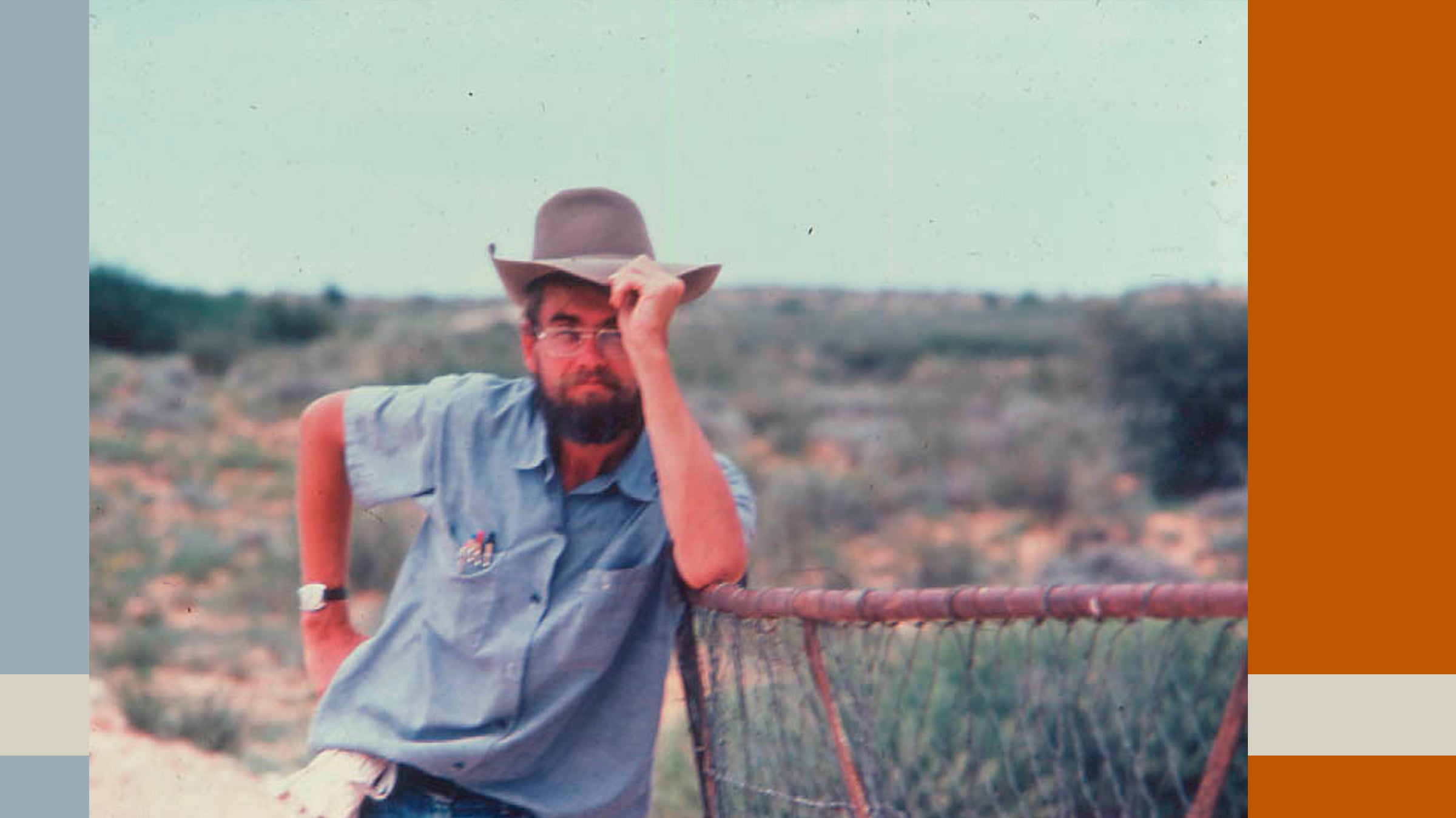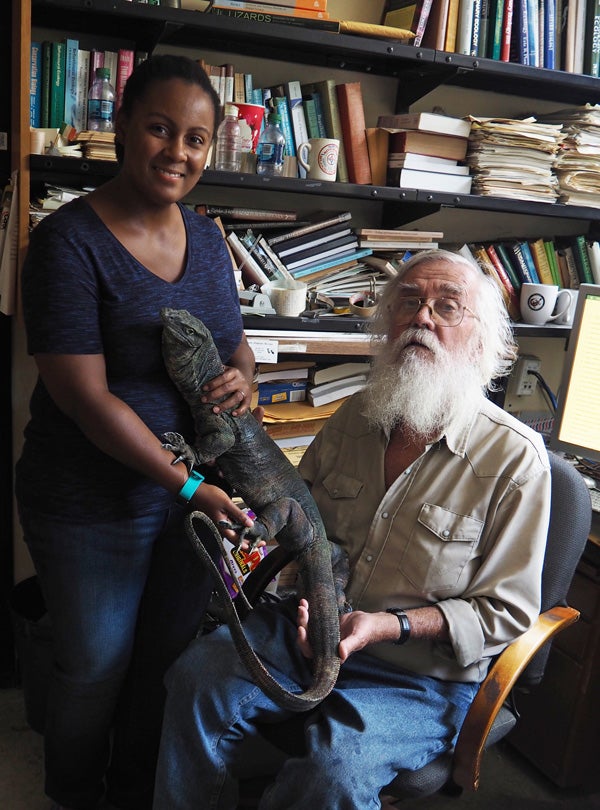
Pianka in his office at UT Austin. (Photo: Larry Gilbert)
Eric Pianka is an evolutionary ecologist of enormous influence who has spent his life studying lizards. Nicknamed “The Lizard Man,” his research covers a broad range of topics pertaining to the ecology, biology and evolution of lizards, including rarity and responses to fire. His work has contributed to the understanding of ecology, population growth, and evolution. He is considered by colleagues as one of the last explorer-naturalists, biologists who spent great amounts of time in the field similar to how many 19th century naturalists would. UT colleague Lawrence Gilbert recalls being inspired as student 54 years ago by Pianka’s thoughts on species diversity.
Pianka was born on January 23, 1939 in northern California. He developed his interest in lizards around the age of five, and it would be a fascination that stayed with him his entire life. His mother was very supportive of young Eric’s interest in herpetology, allowing him to keep snakes in the house and take long drives to search for lizards, snakes, amphibians, birds and insects. When he was a teenager, he was seriously injured by a blast from a bazooka shell that he and his friends discovered several days after a military exhibition. His recovery was long, and he lost the terminal digit on the middle finger of his right hand, 10 cm of his tibia (shinbone), and his left leg became riddled with gangrene. This injury would leave him with a shorter and partially paralyzed leg, which would lead to scoliosis and spondylosis. Pianka later would recount how that event would turn out to be a life-shaping and character-building experience, and he never allowed his physical disabilities hinder his efforts in field research.
While an undergraduate at Carleton College, Pianka floundered between becoming a geologist or a biologist. When he had a negative experience with a geologist during his junior year, he decided biology was the right path. Pianka graduated from Carleton College in 1960 with a B.A. in Biology. He earned his Ph.D. from the University of Washington, Seattle, in 1965. He did postdoctoral work with the eminent ecologist Robert MacArthur at Princeton University. MacArthur had an outsized impact on ecology, and is perhaps best remembered for having brought mathematical formulations into ecological theory. MacArthur deeply influenced Pianka’s thinking, and the two of them coauthored a classic paper on optimization strategies in ecology.

Pianka in the Kalahari Desert in 1975. (Photo: Raymond Huey)
When Pianka was just starting his career, ecology and evolution were two largely separate areas of research. Ecologists studied things such as: why do species occur in certain habitats and places?, and what factors regulate plant and animal abundance? On the other hand, evolutionary biologists were focused on the reconstruction of evolutionary trees and understanding the mechanisms that cause evolutionary change. In his 1973 book Evolutionary Ecology, Pianka tried to merge the two fields by revealing ways evolution impinges on ecology and how ecology influences evolutionary patterns. This was new for its time and influenced many scientists to think differently about biological diversity. Pianka was interested in understanding why a certain regions, such as the Great Victoria Desert in Australia, would have enormous lizard biodiversity, and another area might have only have just one or two lizard species. Pianka addressed this basic question from a broad geographic and evolutionary perspective as well as from a more local and contemporary perspective involving species interactions within local habitats.
In 1968, Pianka began teaching at UT Austin, and would teach here until his retirement fifty-two years later in 2020. His research focused on both empirical and theoretical aspects of ecology and evolution, including niche theory, functional traits, life history theory, community structure and landscape ecology. Because of his reputation, he attracted many students to UT Austin, students who wanted to study with him and who would themselves become leaders in their field, such as Kirk Winemiller at Texas A&M and Raymond Huey at the University of Washington. Students remember Pianka as direct and tough, but enormously impactful on their learning. Winemiller, when ready to apply for PhD study, wanted to study under Pianka and inquired about the possibility. He received back the famous “plumber letter,” in which Pianka explained that PhD study in ecology should only be undertaken by those obsessed with a career in ecology; otherwise it’s better to train to become a plumber, because society values plumbers and the job pays better. Gilbert mentioned hearing consistent praise from top senior students taking his field ecology class when asked about their impressions of Pianka’s signature undergraduate course “Evolutionary Ecology”. Pianka retired in 2020 as a Denton Cooley Professor Emeritus after a distinguished career in the departments of Zoology and Integrative Biology at UT Austin.

Dr. Melissa Kemp and Pianka (Photo: Larry Gilbert)
Pianka’s love of being in the field has taken him to some challenging locations. He’s done extensive ecological investigations on vertebrate communities in some of the world’s most inhospitable places: Great Basin, Mojave, and Sonora deserts in North America; the Kalahari Desert in Africa; and the Great Victorian Desert in Western Australia. Much of this research he did alone. Pianka frequently wrote about how deserts are his favorite places, owing to their openness and lack of human presence, some of the Earth’s last pristine ecosystems where one can still find solitude.
Pianka has approximately 150 publications. The first one appeared in 1959 while he was still a junior in college, due to supportive direction by Hobart Muir Smith, one of the most prolifically published herpetologists. Pianka has written several seminal papers on topics such as life history strategies, ecological optimization, thermal ecology, resource partitioning, lizard evolution, and diversity gradients, amongst other topics. His 1966 paper Latitudinal gradients in species diversity is considered a citation classic that has been inspirational to many biologists and conservationists. This paper was one of the first to synthesize ideas on why there are more species in the tropics than in higher latitudes. Other citation classics are On r and k selection (1970) and On optimal use of a patchy environment (1966).
His honors are numerous, some of which include Guggenheim Fellow (1980), American Association for the Advancement of Science Fellow (1981), Denton A. Cooley Centennial Professor (1986), Fulbright Senior Research Scholar (1990), and elected member of the American Academy of Arts and Sciences (2014). Pianka received the 2006 Distinguished Texas Scientist Award from the Texas Academy of Science. In 2015, he received the Eminent Ecologist Award, the highest award of the Ecological Society of America.
An Australian skink (Ctenotus piankai) and two lizard parasites (Oochoristica piankai, Skrjabinodon pinakai) are named after him. In 2009, Pianka and his research were featured in Lizard Kings, a wildlife documentary that premiered in 2009 on the PBS NOVA series.
Eric Pianka pioneered biodiversity studies before it was cool and had a name. His active career at UT Austin and sojourns in deserts of the world studying lizards will be missed by all who value natural history and wild nature on planet earth.
For more information on Eric Pianka, visit these sites:
UT webpage: http://www.zo.utexas.edu/faculty/pianka/eric.html
List of books: http://www.zo.utexas.edu/courses/THOC/Books.html
A "pre-obituary," with plenty of humor: http://www.zo.utexas.edu/faculty/pianka/obit.html
Special thanks to Dr. Larry Gilbert, Dr. Raymond Huey, and Dr. Kirk Winemiller for their assistance with this article.



